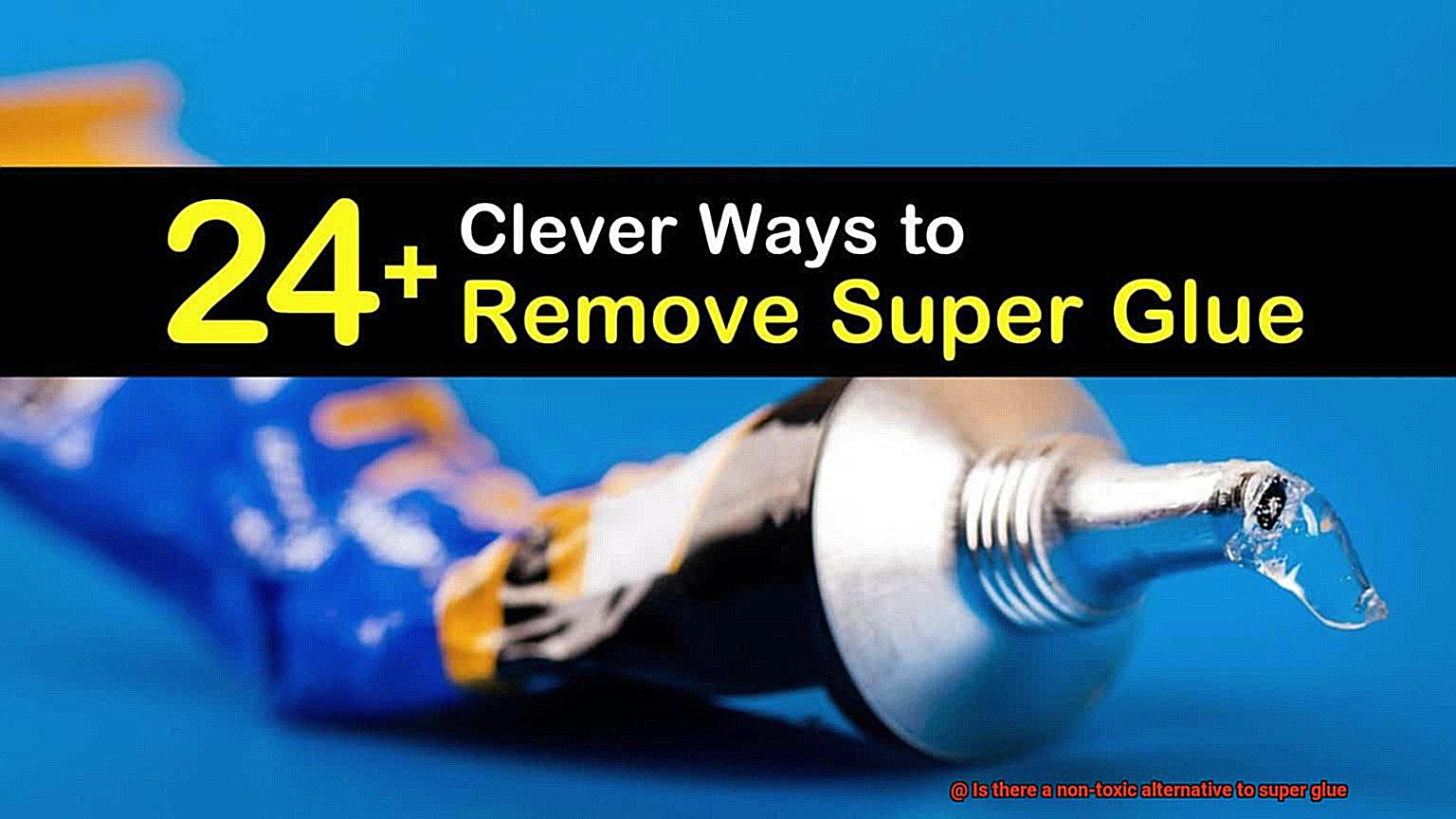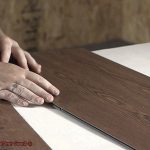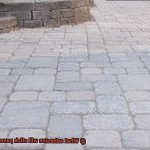Step into the world of glue, where sticky situations call for an adhesive hero.
We’ve all experienced it – a shattered heirloom, a sole that’s come undone, or a beloved trinket in need of repair. Super glue has long been the trusty companion for mending these mishaps, but its toxic nature leaves us questioning whether there’s a safer option out there.
Fear not. There are non-toxic alternatives to super glue that can bond materials without compromising your well-being.
So buckle up and get ready to discover the perfect glue for your next project – one that sticks things together while keeping you free from harm.
Natural plant-based adhesives as an alternative
Contents
- 1 Natural plant-based adhesives as an alternative
- 2 Casein glues: A non-toxic option for woodworking
- 3 Gel adhesives: Non-toxic, versatile, and strong bonding capabilities
- 4 Adhesive tapes as a safe alternative to traditional glue
- 5 Considerations when choosing a non-toxic alternative to super glue
- 6 e.g., materials involved, application requirements)
- 7 Instant bond vs. drying/curing time: Understanding the trade-off
- 8 Safety precautions when working with non-toxic adhesives
- 9 Popular brands offering non-toxic alternatives to super glue
- 10 Conclusion
In an era of growing environmental consciousness, finding sustainable and non-toxic alternatives to everyday products is paramount. Enter natural plant-based adhesives, a game changer in the world of adhesives. These eco-friendly alternatives offer a multitude of advantages and potential applications, making them an excellent choice for those seeking a safer and greener option.
Advantages of Natural Plant-Based Adhesives:
- Non-toxic and Safe: Unlike traditional super glue, natural plant-based adhesives are derived from renewable plant sources, ensuring they are non-toxic and safe to use. Say goodbye to harmful chemicals like cyanoacrylates that can cause irritation and allergic reactions.
- Biodegradable and Environmentally Friendly: Plant-based adhesives break down naturally over time without leaving behind harmful residues, making them biodegradable. By choosing natural plant-based adhesives, you contribute to reducing waste accumulation and pollution, making it an environmentally conscious choice.
- Renewable and Sustainable: Derived from renewable plant sources such as starches, gums, resins, and oils, natural plant-based adhesives ensure a sustainable supply of raw materials. This renewable nature helps conserve natural resources and reduces dependence on non-renewable petroleum-based adhesives.
- Versatile Applications: Natural plant-based adhesives offer a wide range of applications. Starch-based adhesives are effective for bonding materials in crafts and woodworking projects. Gum-based adhesives, like gum arabic, find use in the food industry due to their stabilizing properties. Resin-based adhesives are ideal for carpentry and woodworking applications. Plant oils, such as soybean or linseed oil, can be used in various adhesive formulations.
Potential Applications:
- Crafts and DIY Projects: Natural plant-based adhesives provide a strong bond for paper, cardboard, fabric, and other craft materials, making them perfect for crafts, scrapbooking, and other DIY projects.
- Woodworking and Carpentry: Resin-based adhesives derived from pine trees offer excellent bonding strength for woodworking and carpentry projects. They securely join pieces of wood together.
- Food Industry: Gum-based adhesives, such as gum arabic, are commonly used in the food industry as stabilizers and emulsifiers. Improve the texture and stability of food products with these plant-based adhesives.
- Medical Applications: Natural plant-based adhesives have potential medical applications, such as wound closure or surgical procedures. Their non-toxic nature reduces the risk of adverse reactions and promotes better healing.
Casein glues: A non-toxic option for woodworking
Woodworking, a craft spanning centuries, has seen the evolution of tools and materials. Amidst the choices, casein glue, derived from milk proteins, remains a steadfast option. This adhesive offers woodworkers a non-toxic alternative, prioritizing health and safety without compromising on quality.
Benefits of Casein Glue:
Non-Toxic Nature:
Casein glue’s greatest strength lies in its non-toxic nature. Unlike traditional adhesives laden with harmful chemicals, casein glue is a result of curdling milk with natural acidity like vinegar or lemon juice. This organic process ensures that casein glue is safe for use even in enclosed spaces around children and pets.
Exceptional Bonding Properties:
Renowned for its exceptional bonding properties, casein glue excels in joining wood together. It dries to a robust finish, ideal for both indoor and outdoor applications. Whether crafting furniture, cabinetry, or other woodworking projects, casein glue guarantees a strong and reliable bond.
Reversibility:
Another advantage of casein glue lies in its reversibility. Should a joint require disassembly or repair, water can soften the glue for easy removal. This versatility makes casein glue an ideal choice for woodworking projects that may necessitate future adjustments or modifications.
Environmentally Friendly:
By opting for casein glue, woodworkers can reduce their environmental impact while enjoying their craft. Derived from renewable sources like milk proteins, casein glue naturally degrades over time without leaving behind harmful pollutants or chemicals.
Considerations:
While casein glue boasts numerous benefits, it is important to note its limitations. Unlike certain adhesives, casein glue is not waterproof and may not be suitable for moisture-exposed applications. Additionally, its relatively short shelf life may require fresh preparation for each use.
Gel adhesives: Non-toxic, versatile, and strong bonding capabilities

When it comes to tackling DIY projects or fixing things around the house, finding the right adhesive is crucial. That’s where gel adhesives come into play. These remarkable and versatile adhesives offer a plethora of advantages that make them the go-to choice for glue enthusiasts. Let’s delve into the world of gel adhesives and uncover their non-toxic nature, their ability to bond various materials with ease, and their exceptional strength when it comes to creating lasting bonds.
First and foremost, gel adhesives boast a commendable trait – they are non-toxic. Unlike some other adhesives currently on the market, gel adhesives do not contain harmful chemicals or emit toxic fumes. This makes them not only a safer choice for your health but also a more environmentally friendly option. Say farewell to concerns about inhaling toxic fumes or exposing yourself to harmful substances. With gel adhesives, you can focus on your project with peace of mind.
But the advantages of gel adhesives don’t stop there. They are incredibly versatile as well. From wood to metal, glass to ceramics, and even plastics, gel adhesives possess the remarkable ability to bond a wide range of materials together. Regardless of whether you’re working on repairing a piece of wooden furniture or creating an intricate mixed-media masterpiece, gel adhesives have got you covered. With these adhesives by your side, there’s no need for multiple types of glue cluttering up your workspace – one tube of gel adhesive can handle it all.
And let’s not forget about their exceptional strength when it comes to bonding. Once cured, gel adhesives provide a durable and long-lasting bond that can withstand everyday wear and tear. Whether you’re joining two small pieces or embarking on a larger project, rest assured that gel adhesives will create a secure bond that holds strong.
What sets gel adhesives apart is their unique consistency. Unlike runny liquids or thick pastes, gel adhesives come in a gel-like form that makes them easy to use and apply. They won’t drip or slide off your project, allowing for precise application and control. Moreover, the longer curing time of gel adhesives gives you the freedom to position and adjust your objects before the bond fully sets, ensuring a perfect result every time.
But wait, there’s more. Some gel adhesives are even waterproof and resistant to extreme temperatures, making them suitable for both indoor and outdoor projects. Whether you’re fixing a broken garden ornament or constructing a sturdy outdoor structure, gel adhesives rise to the occasion.
Now, where can you find these incredible gel adhesives? Look no further than your local hardware store or online retailers. Tubes or syringes of your preferred gel adhesive are easily accessible, allowing you to dive into your next project without delay.
Adhesive tapes as a safe alternative to traditional glue
Look no further. Adhesive tapes are here to revolutionize your bonding experience as a safe alternative to traditional glue. Whether you’re a passionate crafter, a parent looking for kid-friendly options, or simply someone who values convenience and safety, adhesive tapes offer a range of advantages that make them the perfect choice for all your bonding needs.
Non-Toxic Wonder:
One of the standout features of adhesive tapes is their non-toxic nature. Say goodbye to harmful chemicals like formaldehyde and toluene. Unlike traditional glue, adhesive tapes are made from materials such as paper, fabric, or plastic that are considered safe for everyday use. You can enjoy your crafting sessions or fix household items without worrying about inhaling or ingesting toxic fumes. Safety is a top priority, and adhesive tapes deliver on that promise.
Ease of Use:
Instant bonding at your fingertips. Adhesive tapes offer unmatched ease of use. No more waiting for glue to dry or dealing with sticky fingers. Simply peel off the backing and press the tape onto your desired surface. It’s as easy as 1-2-3. This makes adhesive tapes particularly convenient for quick fixes or temporary projects where time is of the essence. Get the job done in no time with adhesive tapes.
Versatility at Its Best:
Adhesive tapes come in various types, each designed for specific purposes. Double-sided tape is perfect for crafts or attaching lightweight objects effortlessly. Need something stronger? Duct tape is renowned for its remarkable strength and durability, making it suitable for repairs or even creative endeavors. There’s an adhesive tape tailored to meet the demands of any project. From crafting to repairing, adhesive tapes have got you covered.
Removability without Damage:
No more sticky residue or damage left behind. Adhesive tapes can be peeled off cleanly without causing any damage to surfaces. Unlike traditional glue that often requires harsh solvents for removal, adhesive tapes make clean-up a breeze. Say goodbye to the frustration of removing dried glue residue. Whether you need to reposition or complete a temporary project, adhesive tapes are your go-to solution.
Considerations when choosing a non-toxic alternative to super glue
Super glue, renowned for its incredible bonding strength, has long been a go-to adhesive for various projects. However, its toxic nature poses safety and environmental concerns. Fortunately, there are non-toxic alternatives available that offer similar performance without the harmful side effects. In this comprehensive guide, we will explore the key considerations when choosing a non-toxic alternative to super glue.
Ingredients:
The first consideration is the ingredients used in the adhesive. Opt for water-based adhesives or those made from plant-based materials. These alternatives are often free from harmful chemicals and provide a safer option for users.
Safety:
Safety should always be a top priority when selecting an adhesive. Read product labels and search for certifications or safety standards that guarantee non-toxicity. Additionally, consider the application method to avoid potential risks like fumes or excessive heat.

Bonding Strength:
Super glue is known for its strong bond, so seek alternatives that boast similar capabilities. Look for products that specify their bonding strength and suitability for different materials. Ensure your chosen adhesive can handle the level of adhesion you require.
Drying Time:
Consider how quickly your chosen adhesive dries. While some non-toxic alternatives may have longer drying times than super glue, it’s essential to find a balance between convenience and effectiveness for your specific needs. Look for products that offer reasonable drying times without compromising performance.
Versatility:
Evaluate the versatility of the alternative adhesive. Super glue is typically used for bonding small objects, but alternatives that can bond various materials and surfaces will provide more options for different projects. Choose an adhesive that can handle a wide range of materials to maximize its usefulness.
Ease of Use:
Choose an adhesive that is easy to apply and use. Look for convenient applicator bottles or user-friendly features that simplify the application process. Avoid complex mixing or preparation steps, as they may deter beginners or those seeking hassle-free solutions. A user-friendly adhesive ensures a smooth and enjoyable bonding experience.
Durability:
Consider the durability of the adhesive under different conditions. Super glue excels in high-stress situations, so seek alternatives that can withstand temperature changes, moisture, and other environmental factors without compromising their bonding strength. Look for products that explicitly mention their durability and resilience.
e.g., materials involved, application requirements)
Say goodbye to your worries about toxic adhesives. In this captivating blog post, we will take you on a journey into the fascinating realm of non-toxic alternatives to super glue. Explore the materials involved and application requirements as we guide you towards making an informed choice for your adhesive needs.
Materials Involved:
Step into a world where safety meets innovation. Non-toxic alternatives to super glue utilize unique ingredients and mechanisms to achieve bonding capabilities without compromising your well-being. These alternatives often feature natural, plant-based ingredients like soy or vegetable-based adhesives, along with water-based formulas. By opting for these non-toxic options, you can enjoy peace of mind, knowing that both you and the environment are safe from harm.
Application Requirements:
Applying non-toxic alternatives is a breeze, similar to using traditional super glue. Cleanliness remains crucial, ensuring the surfaces to be bonded are dry and free from debris. However, these alternatives offer something extra – greater flexibility. Unlike super glue, non-toxic alternatives can bridge small gaps, making them perfect for projects where a perfect fit isn’t always possible.
Bonding Strength and Drying Time:
Prepare to be amazed by the impressive bonding strength of non-toxic alternatives. They rival their traditional counterparts in providing sturdy connections. To ensure success, select an alternative that suits your specific project requirements. Keep in mind that drying times may vary compared to the quick-setting nature of super glue. Some alternatives might require more time to dry thoroughly. However, considering the enhanced safety they offer, this trade-off is undoubtedly worthwhile.
Versatility and Durability:
The world of non-toxic alternatives caters to various applications. Whether you’re engaged in craft projects or tackling repairs around the house, there’s an option available for your every need. These alternatives also boast exceptional durability, ensuring that your bonded materials remain securely in place over time.
Instant bond vs. drying/curing time: Understanding the trade-off
Prepare for a journey that will leave you stuck (pun intended) as we explore the trade-off between these two adhesive options.
Instant Bond Glues:
Let’s begin with the speed demons of the glue universe – instant bond glues. These magical potions, like super glue, work their wonders by creating a strong bond within seconds of application. Perfect for those “oops” moments when time is of the essence, instant bond glues allow immediate use or handling of your precious creations.
However, like any enchantment, instant bond glues have their limitations. They excel on non-porous surfaces such as metal, glass, or plastic, creating a tight seal that is hard to beat. Yet, when it comes to porous materials like wood or fabric, these speedy solutions may not provide the robust hold you desire.
Drying/Curing Time Glues:
Now let’s turn our attention to the more patient adhesive options. These glues demand a bit more time and tender loving care to reach their full potential. Liquid glues often require air drying, while curing adhesives may need specific conditions like heat or UV light exposure. The result? A bond that is stronger and more durable than any instant bond.
The waiting game may not suit everyone’s taste, but if you crave a long-lasting hold on a variety of materials, glues with longer drying or curing times are your best bet. Their ability to penetrate porous surfaces like wood allows for a deeper bond, ensuring your creations withstand the test of time.
Choosing the Right Adhesive:
So how do you decide which adhesive is right for you? Consider the specific application and requirements of your project. Instant bond glues are perfect for quick repairs or temporary fixes, while drying/curing time glues are ideal for permanent and robust bonds.
Your skill level and experience also play a role in this sticky decision. Instant bond glues demand precision and careful application, as they bond quickly and can be tricky to reposition once applied. Glues with longer drying or curing times offer flexibility, allowing adjustments and repositioning before the adhesive fully sets.
Conclusion:
Glue enthusiasts, behold the delicate dance between instant bond and drying/curing time. Instant bond glues deliver speed and convenience, while glues with longer drying or curing times provide a more durable hold on a variety of materials.
Safety precautions when working with non-toxic adhesives
Step into the enchanting world of adhesives, where bonds are formed and creativity thrives. If you’re eager to learn about the safety precautions when working with non-toxic adhesives, you’ve come to the right place. While these adhesives are generally safer than their toxic counterparts, it’s still important to take certain measures to ensure a safe and enjoyable crafting experience. So, grab your gloves – let’s dive into the realm of safety precautions.
Enchanting Ventilation:
Just as fresh air is vital for our well-being, proper ventilation is crucial when working with non-toxic adhesives. Although these adhesives may not emit strong fumes, it’s important to have adequate airflow to prevent the buildup of potentially harmful vapors. Open a window or work in a well-ventilated area to keep your creative space fresh and delightful.
Glove Up for Protection:
Unleash your inner wizard by donning protective gloves when handling non-toxic adhesives. These gloves will shield your skin from potential irritation or allergic reactions that may occur. Look for chemical-resistant gloves that provide a good grip, ensuring you can work your magic safely and effectively.
Bewitching Eye Care:
Even though non-toxic adhesives are kinder to our senses, we must still protect our precious eyes. Accidental contact can cause discomfort or irritation. If this happens, don’t panic. Simply flush your eyes with clean water for several minutes and seek medical attention if needed. Remember, safety starts with seeing clearly.
Follow the Spellbook – Manufacturer’s Instructions:
Every potion has its spell, and every adhesive has its instructions. To ensure effective bonding and minimize risks, follow the manufacturer’s guidelines carefully. Different products may have specific usage recommendations, drying times, or temperature requirements. By adhering to these instructions, you’ll be crafting with confidence.
Keep Magic Out of Reach:
While our enchanting adhesives may seem harmless, they can still bewitch little ones and furry friends. Store your non-toxic adhesives in a secure place, away from curious hands or paws. Ingestion or misuse can lead to accidents or health issues. Remember, it’s better to keep magic safely contained.
Banish Sticky Messes:
In the midst of our magical creations, spills and excess adhesive may appear like unruly spells gone wrong. Swiftly clean up these sticky messes to avoid slipping hazards or damage to surfaces. Refer to the adhesive manufacturer’s recommendations for appropriate cleaning agents and techniques – it’s the secret to a tidy and safe workspace.
Popular brands offering non-toxic alternatives to super glue
There are plenty of non-toxic alternatives available in the market that offer a safe and effective way to bond materials together. In this blog post, we will explore some popular brands that offer non-toxic alternatives to super glue, so you can unleash your creativity without any worries.
First up on our list is Gorilla Glue. Known for their high-quality adhesives, Gorilla Glue offers non-toxic alternatives that are formulated with water-based materials. These glues are safe for both adults and children, providing a strong bond on various materials like wood, plastic, and metal.
Next, we have Elmer’s, a trusted brand widely used in schools and homes. Elmer’s non-toxic alternatives are water-based and washable, making them perfect for craft projects or bonding porous materials like paper, fabric, and foam. Plus, they are acid-free, ensuring they won’t damage delicate or archival materials.
If you’re into crafting, you’ve probably heard of Aleene’s Original Tacky Glue. This versatile adhesive is water-based and dries clear, providing a strong hold on surfaces like paper, fabric, wood, ceramics, and more. Aleene’s non-toxic glue is a staple in many crafting projects due to its reliability.
For those who need a fast-drying adhesive, Beacon Zip Dry is the brand to go for. Their non-toxic alternative to super glue is safe for general use and dries clear. It works well on materials such as paper, cardboard, and fabric, providing a strong bond. Beacon Zip Dry is often used for scrapbooking or card-making.
Last but not least, we have Mod Podge. This versatile craft adhesive offers non-toxic alternatives that are water-based and provide a clear, durable finish. Mod Podge can be used for a variety of purposes like decoupage, sealing, and bonding. It works on surfaces like paper, fabric, wood, glass, and more.
8g2REE6z9V8″ >
Also Read: Does Krazy Glue Work on Metal?
Conclusion
Yes, there are non-toxic alternatives to super glue that can be just as effective. These alternatives provide a safer option for those who are concerned about the toxic fumes and potential health risks associated with traditional super glue.
One such alternative is called cyanoacrylate glue, which is commonly known as “crazy glue” or “instant glue.” It bonds quickly and securely, but it is also non-toxic and does not emit harmful fumes. This makes it a great choice for craft projects or repairs where safety is a priority.
Another non-toxic alternative is epoxy resin adhesive. This adhesive consists of two parts that need to be mixed together before use. Once mixed, it forms a strong bond that can withstand various conditions. Epoxy resin adhesive is often used in woodworking and jewelry making due to its versatility and non-toxic nature.
Furthermore, some natural adhesives like vegetable-based glues or starch-based pastes can also serve as non-toxic alternatives to super glue. These options may not have the same level of strength as traditional super glue, but they are safe to use and environmentally friendly.
In conclusion, if you’re looking for a non-toxic alternative to super glue, there are several options available. From cyanoacrylate glues to epoxy resin adhesives and natural alternatives, you can find a solution that meets your needs while prioritizing safety.






